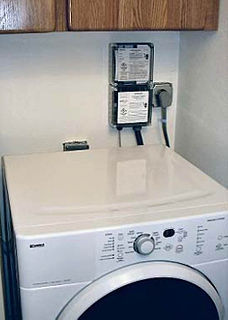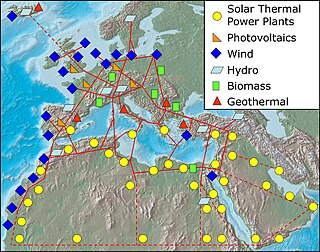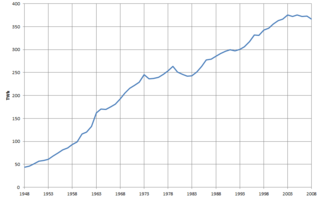
The electric power industry covers the generation, transmission, distribution and sale of electric power to the general public and industry. The commercial distribution of electric power started in 1882 when electricity was produced for electric lighting. In the 1880s and 1890s, growing economic and safety concerns lead to the regulation of the industry. What was once an expensive novelty limited to the most densely populated areas, reliable and economical electric power has become an essential aspect for normal operation of all elements of developed economies.

In the electricity sector in the United Kingdom the National Grid is the high-voltage electric power transmission network serving Great Britain, connecting power stations and major substations and ensuring that electricity generated anywhere on it can be used to satisfy demand elsewhere. The network covers the great majority of Great Britain and several of the surrounding islands. It does not cover Ireland; Northern Ireland is part of a single electricity market with the Republic of Ireland.

Grid energy storage is a collection of methods used to energy storage on a large scale within an electrical power grid. Electrical energy is stored during times when electricity is plentiful and inexpensive or when demand is low, and later returned to the grid when demand is high, and electricity prices tend to be higher.
Renewable Energy Certificates (RECs), also known as Green tags, Renewable Energy Credits, Renewable Electricity Certificates, or Tradable Renewable Certificates (TRCs), are tradable, non-tangible energy commodities in the United States that represent proof that 1 megawatt-hour (MWh) of electricity was generated from an eligible renewable energy resource and was fed into the shared system of power lines which transport energy. Solar renewable energy certificates (SRECs) are RECs that are specifically generated by solar energy. Renewable Energy Certificates provide a mechanism for the purchase of renewable energy that is added to and pulled from the electrical grid. The updated Greenhouse Gas Protocol Scope 2 Guidance guarantees of origin, RECs and I-RECs as mainstream instruments for documenting and tracking electricity consumed from renewable sources.

Demand response is a change in the power consumption of an electric utility customer to better match the demand for power with the supply. Until recently electric energy could not be easily stored, so utilities have traditionally matched demand and supply by throttling the production rate of their power plants, taking generating units on or off line, or importing power from other utilities. There are limits to what can be achieved on the supply side, because some generating units can take a long time to come up to full power, some units may be very expensive to operate, and demand can at times be greater than the capacity of all the available power plants put together. Demand response seeks to adjust the demand for power instead of adjusting the supply.

Microgeneration is the small-scale generation of heat and electric power by individuals, small businesses and communities to meet their own needs, as alternatives or supplements to traditional centralized grid-connected power. Although this may be motivated by practical considerations, such as unreliable grid power or long distance from the electrical grid, the term is mainly used currently for environmentally conscious approaches that aspire to zero or low-carbon footprints or cost reduction. It differs from micropower in that it is principally concerned with fixed power plants rather than for use with mobile devices.

Joint Stock Company Inter RAO UES, traded as, is a diversified energy holding company headquartered in Moscow, Russia. Its business includes power and heat generation, electricity supply, international energy trading, engineering, design and development of electric power infrastructure. In addition to Russia it controls several energy companies outside Russia including thermal and hydro power plants, grid operators and energy traders. It holds a monopoly on the export and import of electricity in Russia.

A black start is the process of restoring an electric power station or a part of an electric grid to operation without relying on the external electric power transmission network to recover from a total or partial shutdown.
A feed-in tariff is a policy mechanism designed to accelerate investment in renewable energy technologies. It achieves this by offering long-term contracts to renewable energy producers, typically based on the cost of generation of each technology. Rather than pay an equal amount for energy, however generated, technologies such as wind power and solar PV, for instance, are awarded a higher per-kWh price, while technologies such as tidal power are offered a lower price, reflecting costs that are higher at the moment and allowing a government to encourage development of one technology over another.

Solar power is the conversion of energy from sunlight into electricity, either directly using photovoltaics (PV), indirectly using concentrated solar power, or a combination. Concentrated solar power systems use lenses or mirrors and tracking systems to focus a large area of sunlight into a small beam. Photovoltaic cells convert light into an electric current using the photovoltaic effect.

Availability Based Tariff (ABT) is a frequency based pricing mechanism applicable in India for unscheduled electric power transactions. The ABT falls under electricity market mechanisms to charge and regulate power to achieve short term and long term network stability as well as incentives and dis-incentives to grid participants against deviations in committed supplies as the case may be.
Energinet is the Danish national transmission system operator for electricity and natural gas. It is an independent public enterprise owned by the Danish state under the Ministry of Climate and Energy. Energinet has some 1150 employees, and its headquarters are located in Erritsø near Fredericia in Jutland. The gas division is located in Ballerup near Copenhagen.

An electrical grid, electric grid or power grid, is an interconnected network for delivering electricity from producers to consumers. It consists of:

A super grid or supergrid is a wide-area transmission network that makes it possible to trade high volumes of electricity across great distances. It is sometimes also referred to as a "mega grid".

Energy in Belgium describes energy and electricity production, consumption and import in Belgium.

Energy in Croatia describes energy and electricity production, consumption and import in Croatia.

Denmark's electrical grid is part of the Synchronous grid of Continental Europe. The electricity sector's generation relies on fossil energy and renewable energy: wind power, biogas, biomass and waste. Danish average consumption of electricity per person was 0.8 MWh less than EU 15 average in 2008. Denmark has average electricity costs in EU, but general taxes increase the price to the highest in Europe. In 2015, supply security was over 99.99%, among the highest in the world.

The United Kingdom has a National Grid that covers most of mainland Great Britain and several of the surrounding islands, as well as some connectivity to other countries. As of 2017 the electricity sector in the United Kingdom generation uses around 50% fossil fuelled power, roughly 20% nuclear power and 30% renewable power. Renewable power is showing strong growth, while fossil fuel generator use in general and coal use in particular is shrinking, with coal generators now mainly being run in winter due to pollution and costs.

A grid-connected photovoltaic system, or grid-connected PV system is an electricity generating solar PV power system that is connected to the utility grid. A grid-connected PV system consists of solar panels, one or several inverters, a power conditioning unit and grid connection equipment. They range from small residential and commercial rooftop systems to large utility-scale solar power stations. Unlike stand-alone power systems, a grid-connected system rarely includes an integrated battery solution, as they are still very expensive. When conditions are right, the grid-connected PV system supplies the excess power, beyond consumption by the connected load, to the utility grid.

Variable renewable energy (VRE) is a renewable energy source that is non-dispatchable due to its fluctuating nature, like wind power and solar power, as opposed to a controllable renewable energy source such as dammed hydroelectricity, or biomass, or a relatively constant source such as geothermal power.















